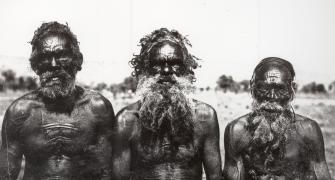The missionaries named the mission Hermannsburg after the seminary in which they had trained and tentatively called the Aboriginal people ‘Aldolinga’, meaning ‘from the west’. However, the landscape was already a cultural landscape intimately known to the Arrarnta people and the site on the upper Finke River is known as Ntaria and is associated with the ratapa (‘twin’) dreaming. 1
Arrarnta people still have their own language and through this that have a direct connection to the land of their ancestors. Their society is still structured by a classificatory kinship system.
At the time of the arrival of the first missionaries the Arrarnta people practiced a rich culture, aspects of which they were happy to share with the missionaries; both Schulze and Kempe witnessed ceremonies. They were present at what they called ‘festivals or dances’ but noted that these were not simply social events but had religious significance. Schulze recorded some of these events which related to initiations and ways of managing species and natural resources:
These festivals serve as reminders, and extol the past, conjoined with prayers that these animals etc., may again appear in the same numbers, of similar size, etc. 2
Some of these ceremonies were huge and drew together Aboriginal people from across large distances. Not all of these were secret. Many ceremonies included women and children in part of the ceremonies. The timing of these ceremonies was sometimes influenced by the availability of water and other resources. Traces of these ceremonies can be seen in the landscape today at some of the art sites that exist in the MacDonnell Ranges.
It is unclear just when the first Arrarnta people settled in the MacDonnell Ranges. However, we know that Central Australia was first settled by Aboriginal people in the time period called the Pleistocene which is a time period that extended up until, around 11,700 years ago. There is archaeological evidence that suggests Aboriginal people were living here from around 60,0000 years ago. There is a general consensus amongst archaeologists that there was population growth and expansion of Aboriginal territories around 1500-1000 years ago. The reason that they believe this is because there are more sites dating to that period and more intensive use of sites than have been found in the years before this. This change may have coincided with the expansion of summer-rainfall grassland and more frequent flood events3. There is a lack of published archaeological research specific to the West MacDonnell Ranges but a little more can be found about the East MacDonnell Ranges.
- Kenny, A 2017 Early ethnographic work at the Hermannsburg Mission p171 citing Carl Strehlow (1907–20: Vol. I, pp. 80–1; Vol. II, p. 72, fn. 3; Vol. III, part 2, pp. 122–4 and T. G. H. Strehlow 1971: 758
- Schulze, L. 1891. The Aborigines of the upper and middle Finke River: Their habits and customs. Transactions and Proceedings of the Royal Society of South Australia 14 /2: 210–46 p244 cited in Kenny 2017p 175.
- Smith, M.A and Ross, J. 2008 What happened at 1500--1000 cal. BP in Central Australia? Timing, impact and archaeological signatures. The Holocene Vol 18:3 379-388. p 387
Media







